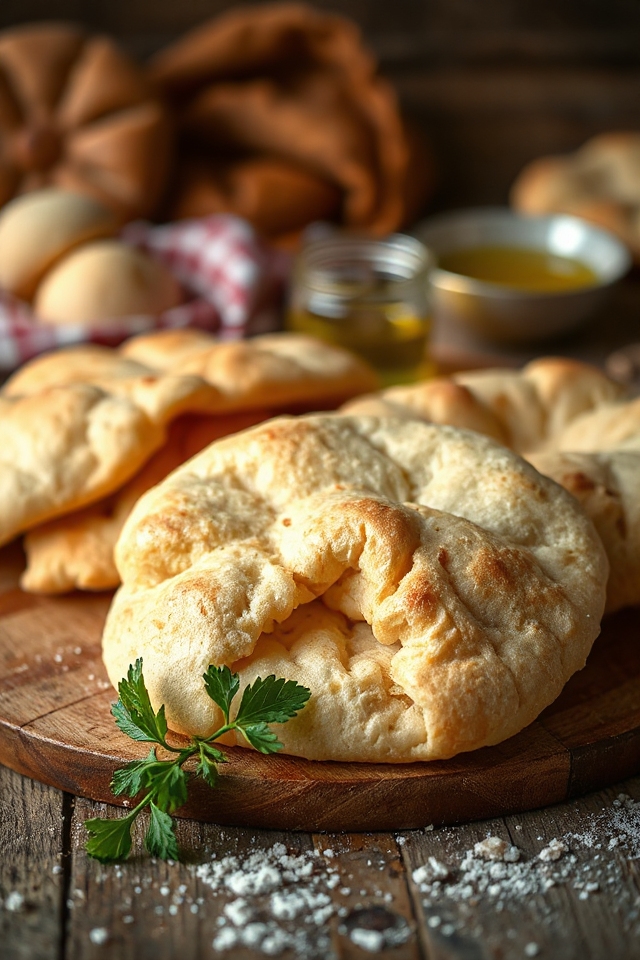Why You’ll Love This Pita Bread Recipe
You’ll absolutely love this pita bread recipe for its simplicity and delicious results.
Making pita bread at home is a rewarding experience that fills your kitchen with irresistible aromas. I appreciate how quick and easy it’s to prepare, requiring just a few basic ingredients.
The best part? You can customize it to suit your taste. Once you take that first bite of warm, fluffy bread, you’ll understand why homemade is always better.
Plus, it’s perfect for dipping, stuffing, or just enjoying on its own. Trust me, once you try it, you won’t want store-bought ever again!
Ingredients of Pita Bread
When it comes to making pita bread, having the right ingredients on hand is vital to achieving that fluffy, warm goodness that we all crave. Luckily, the ingredients list is pretty straightforward, which means you can whip up a batch with minimal fuss. You might already have some of these items tucked away in your pantry.
So, let’s explore what you need to get started on this delightful homemade bread adventure.
Ingredients for Pita Bread:
- 1 (4 ounce) package dried yeast
- 1 teaspoon sugar
- 3 1/2 cups plain flour
- 2 tablespoons olive oil
- 1 1/2 cups lukewarm water
Now, let’s chat a bit about these ingredients. The dried yeast is the magic ingredient that helps your dough rise and gives the pita that wonderful airy pocket, so make sure it’s fresh—if it doesn’t foam up, it’s time to toss it.
And sugar? It’s not just for sweetness; it feeds the yeast, giving it a little boost to get things bubbling. As for the flour, plain flour works well, but if you’re feeling adventurous, whole wheat can be a tasty option too.
Olive oil adds a touch of richness, which is always a good thing in baked goods. Finally, the lukewarm water is essential—it shouldn’t be too hot or too cold; think of it as a cozy bath for the yeast.
Trust me, getting these ingredients right will lead you to a batch of pita bread that you’ll be proud to show off.
How to Make Pita Bread

Alright, let’s explore the delightful world of making pita bread. You’re going to want to start with your 1 (4 ounce) package of dried yeast. Place it in a bowl, along with 1 teaspoon of sugar and 1 1/2 cups of lukewarm water. Give it a gentle stir until everything is nice and dissolved.
Now, here’s the fun part: let it hang out in a warm spot for about 10 minutes. This is when the magic happens. You should see bubbles forming on the surface, and it should be frothy—like a little yeast party in there. If it doesn’t foam up, don’t panic, but do grab some fresh yeast because that one’s taking a nap instead of working.
Once your yeast is all bubbly and alive, you’re ready for the next step. Grab 3 1/2 cups of plain flour and 2 tablespoons of olive oil, and combine them with the yeast mixture. If you’re feeling fancy, you can use a food processor to mix everything for about 30 seconds until it forms a nice dough ball.
But if you’re like me and enjoy a little hands-on action, just use a bowl and a wooden spoon (or your hands) to get everything mixed up until you have a smooth dough. Now it’s time to knead! Turn the dough out onto a well-floured surface and knead it until it feels smooth and elastic. Think of it as a mini workout—who knew making bread could double as exercise?
After all that kneading, toss your dough into a well-oiled bowl, cover it up with some plastic wrap and a tea towel, and let it rise in a warm place for about 20 minutes or until it’s almost doubled in size. It’s like giving your dough a cozy blanket.
When it’s ready, punch it down (yes, that’s part of the process) and divide it into thick rounds about 2 inches thick. Place those on greased baking trays, brush them with water, and let them rise again for another 20 minutes.
Preheat your oven to a sizzling 500°F—this is where the magic happens. Bake the pita for 4-5 minutes, and watch as they puff up like little clouds. The result? Soft, pale, and hollow pockets of joy that are perfect warm or stuffed with your favorite fillings.
Enjoy the process and the delicious aroma that fills your kitchen—you might even feel like a professional baker by the end of it.
Pita Bread Substitutions & Variations
While traditional pita bread is delicious, there are plenty of substitutions and variations that can elevate your baking experience.
For a whole grain option, I love using whole wheat flour instead of plain flour; it adds a nutty flavor. You can also experiment with gluten-free flour blends if you’re avoiding gluten.
For an extra kick, try adding herbs or spices like oregano or garlic powder to the dough. If you’re feeling adventurous, incorporate ingredients like sun-dried tomatoes or olives for a Mediterranean twist.
These variations not only enhance flavor but also bring a unique touch to your homemade pita bread.
Additional Tips & Notes
To guarantee your pita bread turns out perfectly every time, I recommend paying attention to the temperature of your ingredients. Lukewarm water is essential for activating the yeast.
Also, don’t skip the resting periods; they’re vital for developing the dough’s texture. If your pita doesn’t puff up, it might be due to insufficient oven temperature or over-kneading.
For extra flavor, consider adding herbs or spices to the dough. Finally, storing your pita in a sealed bag keeps it fresh; just reheat gently before serving.
Trust me, these small tweaks can elevate your pita bread game greatly!
